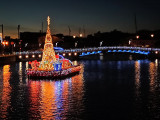Ponts de la passe Nord
Historic site and monument Engineering structure BridgePresentation
The two blue bridges which connect the Ferrières district to the Island have had a long history since they replaced two previous bridges doomed to failure. The first was a turning point to allow boats to pass. The second was fixed.
The year is 1847. A project which provides for the digging of a canal and the development of a pass between Ferrières and the Island to allow ships to access the Etang de Berre is declared useful.
This new bridge must ensure the circulation of pedestrians, carts and carts and maritime traffic. A metal swing bridge was chosen. Its construction began in 1859 and ended in 1861. Its construction was innovative at that time because iron and sheet metal were used.
In the closed position, it is supported on each of the platforms it serves by a 50 meter opening beam whose deck is exactly at the level of the platform.
In the open position, the beam pivots around a central axis. It then has two cantilevered flights of 20 meters each, the central part resting on a circular runway. This raceway is integral with a masonry pile positioned in the middle of the pass. The two flights are therefore in balance.
In 1930, the bridge began to show signs of weakness. Subjected to excessively high traffic loads and frequencies, it causes countless traffic jams. A more modern bridge using the construction methods of the time was decided in 1924. While it was initially intended to provide vertical mobility, the bridge ultimately remained fixed.
In 1999, the city decided to replace this temporary bridge while highlighting the historic axis of Place J. Jaurès towards Rue de la République. Two bridges will be built and inaugurated. One in 2000 and the second in 2001.
The two bridges were prefabricated on the Caronte quays and transported by sea. Vehicle traffic is one-way and a large space is left for pedestrians. The two twin works do not offer exceptional technical characteristics but nevertheless their profile is remarkable. Supported by two cylindrical piers, the deck was lowered on both ends in order to return to the level of the platforms of the first half of the 20th century. Thus Place Jean Jaurès and Rue de la République are once again in the same alignment. The central part of the deck allows the passage of boats thanks to its very marked curved profile.
This new bridge must ensure the circulation of pedestrians, carts and carts and maritime traffic. A metal swing bridge was chosen. Its construction began in 1859 and ended in 1861. Its construction was innovative at that time because iron and sheet metal were used.
In the closed position, it is supported on each of the platforms it serves by a 50 meter opening beam whose deck is exactly at the level of the platform.
In the open position, the beam pivots around a central axis. It then has two cantilevered flights of 20 meters each, the central part resting on a circular runway. This raceway is integral with a masonry pile positioned in the middle of the pass. The two flights are therefore in balance.
In 1930, the bridge began to show signs of weakness. Subjected to excessively high traffic loads and frequencies, it causes countless traffic jams. A more modern bridge using the construction methods of the time was decided in 1924. While it was initially intended to provide vertical mobility, the bridge ultimately remained fixed.
In 1999, the city decided to replace this temporary bridge while highlighting the historic axis of Place J. Jaurès towards Rue de la République. Two bridges will be built and inaugurated. One in 2000 and the second in 2001.
The two bridges were prefabricated on the Caronte quays and transported by sea. Vehicle traffic is one-way and a large space is left for pedestrians. The two twin works do not offer exceptional technical characteristics but nevertheless their profile is remarkable. Supported by two cylindrical piers, the deck was lowered on both ends in order to return to the level of the platforms of the first half of the 20th century. Thus Place Jean Jaurès and Rue de la République are once again in the same alignment. The central part of the deck allows the passage of boats thanks to its very marked curved profile.
Labels
- categories :
General information
- Parking :
- Parking nearby
- Environments :
- In centre of town
- Town location
- Services :
- Pets welcome
- Style :
- Modern
Accessibility
- Accessible to disabled visitors :
- Reception staff sensitized to the reception of people with disabilities
Contact
Ponts de la passe Nord
Quai des Girondins
Ferrières / l'Île
13500
Martigues
Phone : +33 4 42 10 82 90
Tarifs
Free access.

Destination
Ponts bleus de la passe Nord
Quai des Girondins
Ferrières / l'Île
13500
Martigues
GPS coordinates
Latitude : 43.407008
Longitude : 5.054921










